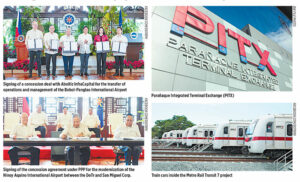Public-private partnerships (PPPs) have been at the core of Philippine infrastructure development and have helped shape the country as we know it today. These agreements between the government and private firms leverage each partner’s expertise to effectively address specific public needs by appropriately distributing resources, risks, and benefits.
The partnerships allow the government to build big-ticket projects that can help millions of Filipinos while minimizing the costs due to the participation of private firms. For companies, PPPs are structured in such a way that the private sector gets a reasonable rate of return on its investment and allows them to contribute to national development.
Notable examples of successful partnerships between the government and private sector include the construction of power plants, waste management systems, irrigations, commerce buildings, and even local city halls. Yet, the industry most aided by PPPs is the transportation sector due to the necessity of developing efficient and modern infrastructure to address the country’s growing population, urbanization, and mobilization needs. Currently, the Department of Transportation (DoTr) handles more than 160 projects, programs, and initiatives — including 74 flagship infrastructure projects of President Ferdinand R. Marcos, Jr.’s administration.
Among the most renowned PPP projects overseen by the DoTr presently operational is the Parañaque Integrated Terminal Exchange (PITX). Developed in partnership with MWM Terminals, a consortium of Megawide Construction Corp. and WM Property Management, Inc., the state-of-the-art terminal, built at a cost of P2.5 billion, has been serving Filipinos since 2019.
PITX boasts several features such as passenger terminal buildings, arrival and departure bays, public information systems, ticketing and baggage handling facilities, and park-ride facilities to give commuters from Southern Luzon to Metro Manila and vice-versa a better experience. Recently, the terminal reached a remarkable milestone of 146 million overall foot traffic since it began operations and is expected to breach the 150-million mark within the year.
Another noteworthy DoTr project constructed with the help of private partnerships is the Metro Rail Transit Line 3 (MRT-3). Completed in the year 2000, the rapid transit line was developed and is currently operated by Metro Rail Transit Corp. Limited with an estimated project cost during approval of P32.75 billion.
Connecting North Avenue and the Epifanio de los Santos Avenue in Quezon City to Taft Avenue in Pasay City, the 13-station and 17-kilometer (km) railway has significantly reduced travel time for commuters and eased traffic congestion for car owners. MRT-3 has a daily ridership of nearly 360,000 passengers and saw almost 130 million passengers in 2023.
Turnover of the operations and management of the Ninoy Aquino International Airport from the DoTr and Manila International Airport Authority to New NAIA Infrastructure Corp. — Photo from facebook.com/DOTrPH
More recently, the Ninoy Aquino International Airport finally gets its long-overdue rehabilitation program through a PPP between the DoTr, Manila International Airport Authority, and New NAIA Infra Corp. (NNIC), a consortium that includes San Miguel Corp. (SMC) and Incheon International Airport Corp. of South Korea.
The modernization program, with an estimated budget cost of P170 billion, hopes to increase the airport’s capacity from 35 million passengers to 62 million passengers and an uptick in air traffic movement from 40 movements per hour to 48, as well as improve service quality. Planned improvements for the airport in the next few years include functional escalators and toilets, stable power and water, improved air-conditioning, runway improvements, increased terminal capacity, improved commercial spaces, and better traffic flow.
Building on the success of these operational projects, the ongoing construction of the Metro Rail Transit Line 7 (MRT-7) further showcases the potential of PPPs to help develop the country. The DoTr’s ambitious project, in collaboration with SMC’s MRT 7, Inc., aims to divert northern provincial bus operations to San Jose Del Monte, thereby decongesting EDSA.
The 23-km elevated railway line will have 14 stations from San Jose Del Monte, Bulacan to MRT-3 North Avenue in Quezon City, while a 22-km asphalt road will also be built from Bocaue Interchange of the North Luzon Expressway (NLEX) to the intermodal terminal in Tala. The P77-billion project currently has an overall construction progress of 71.32% as of June 2024 and a 16.76% right-of-way progress as of May 2024.
The recently opened five stations of the Light Rail Transit Line 1 (LRT-1) is another example of a DoTr project completed with the help of private companies. Developed by the Light Rail Manila Corp. on a Build-Transfer-and-Operate contractual agreement, LRT-1 now runs from FPJ Station (formerly Roosevelt) in Quezon City to Dr. Santos Station in Parañaque thanks to the first phase of the project. With plans to further extend the railway to what would be the Niog Station in Bacoor, Cavite, the whole stretch of the integrated LRT-1 will have a total length of approximately 32.4 kilometers once construction of the nearly P65-billion project is completed. Latest figures show that the LRT-1 transports around 320,000 passengers daily.
In addition to these developments, the New Manila International Airport, also known as the Bulacan International Airport, highlights the continued expansion of the country’s transportation infrastructure through PPPs. The nearly P740-billion project, a collaboration between the DoTr and San Miguel Aerocity, Inc., involves the construction, operation, and maintenance of a new modern airport in Bulacan with a design capacity of up to 100 million passengers per year, consisting of four runways and all aviation-related facilities.
Data on the ongoing land development works for the airport show significant progress, with a total completion rate of 84.61%. Site clearance has been fully completed at 100%, while landfilling is at 77.49%. Ground improvement and right-of-way works are nearing completion, with a progress rate of 94.27% and 99.47% respectively. Finally, the right-of-way for the airport toll road stands at 29.35%.
Aside from these ongoing projects, several key transport developments are lined up to improve the country’s transportation system after Mr. Marcos witnessed the signing of agreements and commitments for the New Cebu International Container Port (NCICP), Cebu Bus Rapid Transit (Cebu BRT), modernization of Bohol-Panglao International Airport, as well as the Agreements for the New Dumaguete and New Siargao airports.
The NCICP aims to decongest the existing Cebu Base Port, improve cargo handling capacity, and reduce logistics costs. In addition, the Cebu BRT is expected to handle 116,000 passengers during partial operations start and over 160,000 passengers once fully operational. The anticipated improvements in the modernization of Bohol-Panglao International Airport include installing modern aviation equipment, expanding the passenger terminal building and other airport facilities. Regional gateways New Dumaguete and New Siargao airports are seen to boost tourism in the area.
Of the five transport projects, only two so far have been awarded to private firms. The International Finance Corp. (IFC) of the World Bank Group was tabbed by the DoTr as the Transaction Advisor in structuring and bidding out the bus supply and operations and maintenance of the Cebu BRT. Similarly, Aboitiz InfraCapital signed a concession deal with the transport department for the transfer of operations and management of the Bohol-Panglao International Airport.
Projects made by the government in partnership with the private sector have and will continue to benefit Filipinos, especially in the transport sector. By combining the strengths of both the government and corporations, these initiatives improve the country’s transportation systems and enhance the quality of life for millions of Filipinos.
With continued collaboration and innovation, the successful implementation of these PPPs promises to pave the way for a more connected, efficient, and sustainable future for the nation. — Jomarc Angelo M. Corpuz

